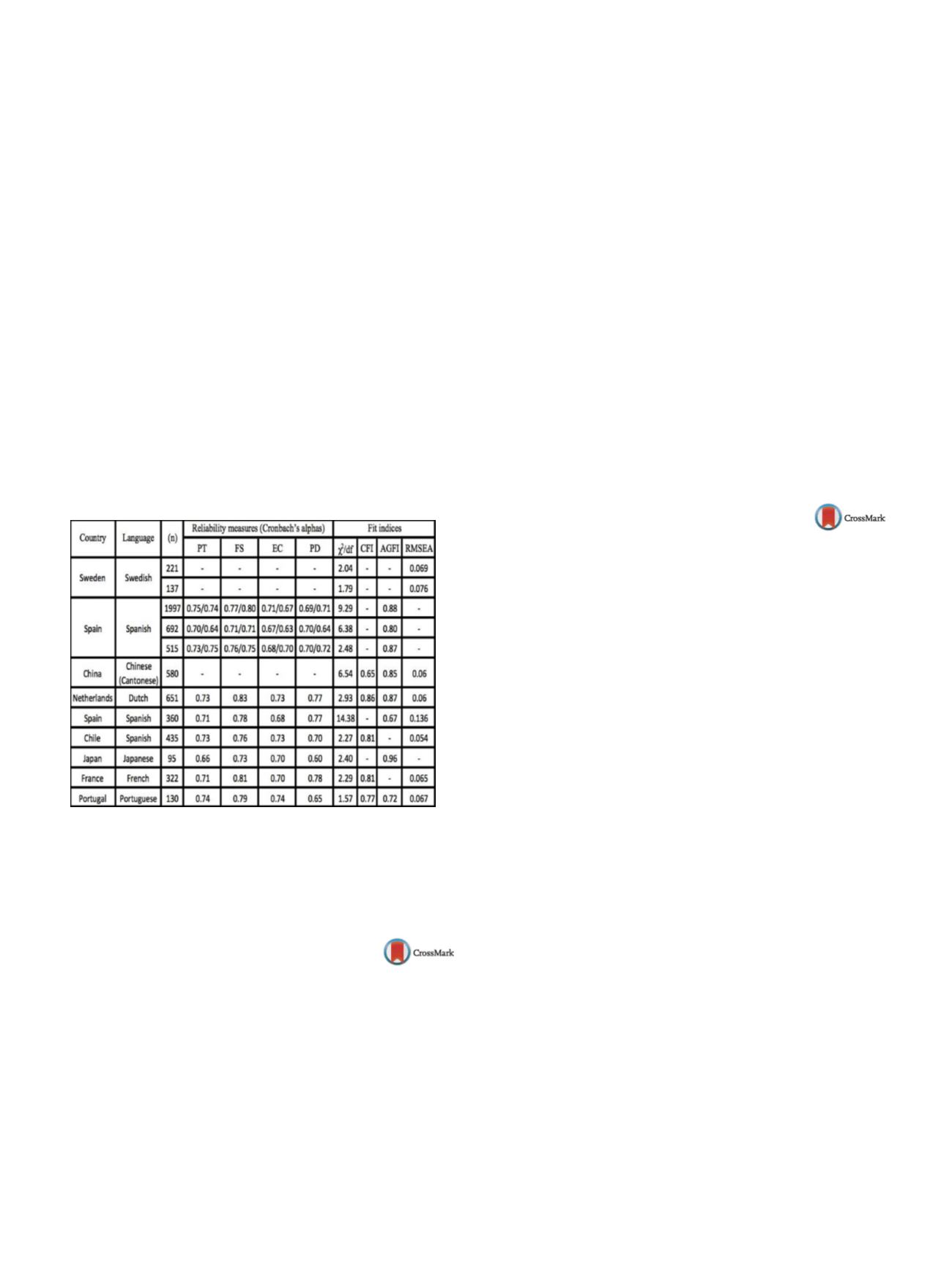

S796
25th European Congress of Psychiatry / European Psychiatry 41S (2017) S772–S846
– empathic concern (EC) scale and iv) personal distress (PD) scale.
Such questionnaires have been translated in many languages (see
Table 1 ).This work aims to compare the original model with exist-
ing modified, hierarchical, shortened models in the literature and
to also translate and validate the IRI for Portuguese.
Methods
A convenience sampling was used (
n
= 130) to conduct
confirmatory factor analysis (CFA) using AMOS software. The origi-
nal four-factor model is contrasted with modified, hierarchical and
shortened models proposed in the literature, reporting internal
consistency statistics and their fit indices.
Results
The same structure of factors was found in the sample
with reasonably good fit indices 2/df = 1.57, CFI = 0.77, AGFI = 0.72
and RMSEA = 0.067. Internal reliability for each scale of the IRI was
not excellent (< 0.90), but it is in line with the literature: PT with
a Cronbach’s alpha of 0.74, FS with 0.79, EC with 0.74 and PD with
0.65. The comparison with other modified versions of the IRI latent
factor structure revealed that two models with better fit than the
original version, and the potential for a shortened Portuguese ver-
sion of the IRI.
Conclusion
IRI is a valid instrument to measure empathy in the
Portuguese Population and is in line with previous findings. Some
modifications to the original latent structure provide a better data
fit than the original one.
Table 1
Validation studies of the 4-factor model structure of the
IRI.
Disclosure of interest
The author has not supplied his/her decla-
ration of competing interest.
http://dx.doi.org/10.1016/j.eurpsy.2017.01.1531EV1202
Development of a new activity
measure: Activity perception in
healthy population and in people with
chronic illness
M. Martin
∗
, I. Alexeeva
University of Oxford, Experimental Psychology, Oxford, United
Kingdom
∗
Corresponding author.
Introduction
Self-reports provide rich information about the
types of activities people engage in. Reviewing current activity
measures two issues become evident. Firstly, they were developed
and validated in healthy populations. Secondly, they are diverse
in their applications and measured domains. Thus, to assess the
construct of activity fully large numbers of measures need to be
used.
Objectives
The study aimed to explore different dimensions of
activity (e.g. work, physical, mental, leisure, sedentary behaviours)
using a new scale assessing multiple domains of daily activities.
Methods
A new activity scale was used to investigate the types
of activity and inactivity in people with chronic illness (asthma,
chronic fatigue syndrome (CFS)) and in a healthy group. The types of
activities measured included; leisure and sport, home and outside,
social activity, work and education, and mental activity. The scale
also aimed to measure the construct of inactivity, represented by
sedentary behaviours, such as staying in bed during the day.
Results
The results showed a pattern of significant correlations
between the new activity scale, specifically its two major domains
of activity and inactivity, and other measures of functioning and
activity in the illness groups, but not in the healthy group.
Conclusions
The lack of significant associations between the new
activity scale and other measures of activity and functioning within
the healthy group indicated the measure may be more suitable for
assessing activity in people with chronic illness than in healthy
people. Additionally, the results underscore the importance ofmea-
suring inactivity as a separate domain.
Disclosure of interest
The authors have not supplied their decla-
ration of competing interest.
http://dx.doi.org/10.1016/j.eurpsy.2017.01.1532EV1203
Outcomes assessment: Reliable
change index (RCI) in assessing health
outcomes in clinical practice
I. Iraurgi
1, P. Penas
1 ,∗
, S. Gorbe˜na
1, M. Montero
1, J. Trujols
21
University of Deusto, Department of Psychology, Bilbao, Spain
2
Hospital de la Santa Creu i Sant Pau, Psychiatric Unit, Barcelona,
Spain
∗
Corresponding author.
Introduction
The assessment of therapeutic outcomes and the
evaluation of treatment efficiency and effectiveness is an area of
interest for clinicians and researchers. Scientific evidence demands
randomized controlled trials and inter-groups comparisons with a
minimum number of participants in each treatment modality, a
requirement rarely feasible in clinical practice where the assess-
ment of treatment outcomes, with regards to therapeutic goals, is
crucial both in terms of statistical significance and clinical rele-
vance.
Objective
The aim of this poster is to present an alternative
methodology which permits to evaluate the individual’s change.
Method
The reliable change index methodology allows for the
estimation of statistical significance (statistically reliable change)
and clinical relevance (calculation of cutoff points and its interpre-
tation criteria). Two examples are presented: a group of patients
with asthma in treatment and a female with major depression who
underwent electroconvulsive therapy (ECT).
Results/discussion
Both cases were analyzed using standardized
statistical analyses and the RCI method in order to estimate clinical
change. The results illustrated the adequacy of both procedures for
decision making in terms of effectiveness. However the RCI offered
greater specificity with regards to individual changes. More specif-
ically, RCI provided a more concrete estimation of the proportion
of cases of asthma that showed change after the intervention, and
also, indicated if such change were not only statistically signifi-
cant, but also clinically relevant. Besides, when a single case was
assessed (ex: ECT case) this methodology proved useful to estimate
the efficacy of a continuation and maintenance program.
Disclosure of interest
The authors have not supplied their decla-
ration of competing interest.
http://dx.doi.org/10.1016/j.eurpsy.2017.01.1533

















